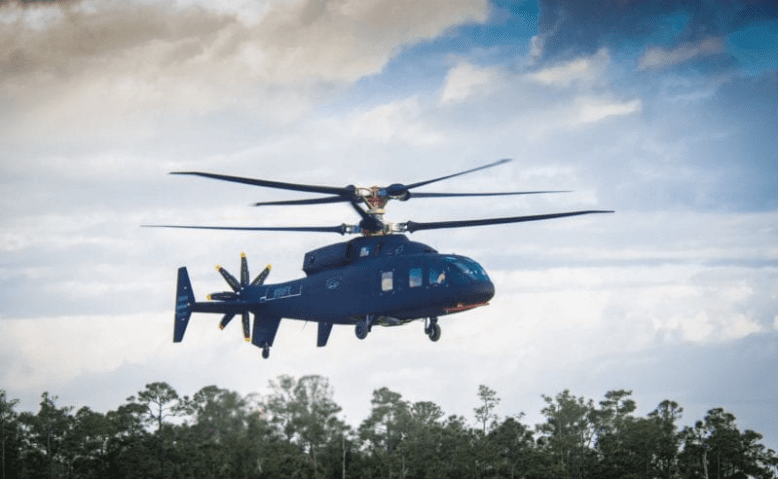
X2 Technology used by the SB>1 Defiant including rigid a rotor system, advanced drive system, and fly-by-wire controls gives pilots more control response and maneuverability at low altitude at high speeds. (Lockheed Martin)
A test pilot gave viewers insight into the flying experience and X2 Technology capabilities of the Sikorsky-Boeing SB>1 Defiant during an Oct. 14 Association of the United States Army (AUSA) webcast hosted by Boeing and Sikorsky. The Sikorsky-Boeing SB>1 Defiant is part of the Army’s Future Vertical Lift (FVL) program.
Bill Fell, a senior experimental test pilot for the S-97 Raider and SB>1 Defiant, explained how the new X2 Technology including rigid rotor system, advanced drive system, and fly-by-wire controls give pilots more control response and maneuverability while flying low altitudes at high speeds.
Fell, who has experience flying Blackhawks and Apaches, compared his experience flying with articulated rotors to Defiant’s new rigid rotor.
“There’s a similar increase in capability when you go from that articulated rotor to that rigid rotor that makes it fly more like a tactical jet than a helicopter it’s very, very quick the response that you can get out of the aircraft,” Fell said.
Ken Eland, senior director of FVL and Future Long-Range Attack Assault (FLRAA) program manager at Boeing, said the X2 Technology allows for more survivability and maneuverability.
“When you look at the capability of an X2 platform with the counter-rotating rigid rotor and the propulsor behind it, you get this combination of a highly maneuverable aircraft,” Eland said. “A rigid rotor is very different than most aircraft so it gives a much better control response for the pilot and then of course the pusher prop brings a whole different level. Most aircraft today, most typical helicopters, work through speed through the pitch of the aircraft. We’ve now become pitch independent with the propulsor system.”
Eland said the Defiant is capable of over 230 knots, which is almost twice the speed of the Blackhawk and the requirement for the FVL program. The fly-by-wire control system allows Defiant to have increased maneuverability at high speeds and low altitudes.
“We can tune that with the flight controls so that we can make it as aggressive as you want the aircraft to be if you’re low and fast through the trees and you’re maneuvering to avoid enemy contact, or you can de-tune it a little bit if you’re flying in the clouds you’re doing an instrument mission, where you don’t want a hot machine and then you tune it appropriately for that mission,” Fell said. “So, the combination of the rigid rotor and the fly-by-wire flight control system adds enormous capability to the Army mission.”
It also allows pilots to use sensors to program systems like autopilot landing which reduces the workload of the pilot and allows their focus to be on the mission, Fell said.
The pusher prop gives the aircraft extra acceleration and deceleration capabilities that have not been previously available. While the acceleration capabilities allow the aircraft to avoid enemy contact, the deceleration capabilities allow the pilot to land the aircraft with more precision.
“The fact is that the helicopters that we have today when you come into that landing zone, you’re going to have to pull the nose up pretty good to slow down if you keep the speed on until the very last moment,” Fell said. “However, with the X2 technology, as you come into that landing zone, you don’t have to do that. You can look at the landing zone the entire time you’re coming into the zone and adjust the thrust on the propulsor so that you stop and you can even stop with the nose a little bit down from the vertical position to give you a better vantage point.”
The X2 uses the pusher prop to give the aircraft both positive and negative pitch. This allows the aircraft to stop quickly even when hitting its top speeds.
“As you’re cruising along at 200 knots, 230 knots, 250 knots, pick the number, that you put that negative pitch onto the pusher prop and you really do kind of feel it tug on your shoulder straps that you’re stopping very rapidly,” Fell said.
Eland said the propulsor system has allowed the aircraft to become pitch independent which will add to its maneuverability capabilities.
Defiant is part of the FLRAA competitive demonstration and risk reduction (CD&RR) in the Army. Bell is also competing in the project with its V-280 Valor. CD&RR is expected to extend over two years with final Army requirements and program of record planned for competition in 2022, according to the Army. FLRAA is expected to achieve a first equipped aircraft in FY30.